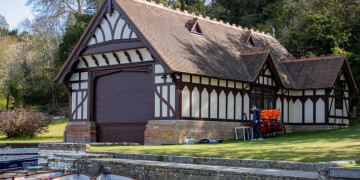Historic Machinery
We have experience in the installation, restoration and operation of a wide range of historic machinery, including steam, gas and oil engines, early hydraulic and electrical equipment, traditional boilers, road/rail vehicles, vessels, and industrial, military and agricultural machinery.
We have designed, installed and commissioned modern drives for a number of large beam and colliery winding engines, written safety and operation guidelines, and provided operator training for several working museums. We have carried out condition surveys, prepared costed repairs schedules and advised on preservation strategies for many historically significant machines nationwide.
For a list of consultancy projects please visit our case studies page.
Here are a few examples of the many projects completed over the last 30 years.
Armstrong Steam Crane, Venice Dockyard
.jpg)

Development of costed conservation proposals for 'Venice in Peril' and the Arsenale, Venice.
Theatre Royal, Drury Lane, London.
.jpg)

The former GWR Workshops at Swindon still retain some interesting machinery from its early days, which I have surveyed and for which I have specified conservation work.
Winding Engine, Pool, Cornwall

The National Trust's winding engine at Pool, Cornwall, is driven by an electric motor acting on the large flywheel. Following a mechanical failure in 2013 Geoff Wallis surveyed the whole engine and specified repairs to the drive equipment.
Elsecar Beam Engines


Thomas Newcomen invented the world's first technically and commercially successful steam engine in 1712. The only example to survive on its original site is at Elsecar Heritage Centre near Barnsley, South Yorkshire. In 2013 Geoff Wallis was appointed Lead Consultant on the Engine to plan and oversee the delivery of a £400K HLF restoration project funded by English Heritage, the Heritage Lottery Fund and Barnsley Council. The Engine featured on a BBC2 programme presented by the Hairy Bikers Dave Myers and Simon King together with Geoff Wallis, seen here after hoisting out the steam piston.

.jpg)

The Elsecar Beam Engine and Shaft are Scheduled Ancient Monuments and listed as Grade 1. The 35m deep shaft is flooded but still contains the original early nineteenth-century cast iron rising main. This was inspected underwater by a side-scanning sonar (blue image), a remote operating vehicle, and subsequently by a team of divers to determine the layout and condition of the submerged metalwork.
National Slate Museum, Llanberis, North Wales

The National Slate Museum at Llanberis in North Wales is housed in a former slate-dressing works that still contains an extensive range of workshops. Machine tools are powered by a large waterwheel driving a long series of line shafts. Over the years serious wear had developed in one heavily-loaded coupling which put the whole system out of operation. Geoff Wallis specified repairs and personally carried out critical on-site machining and key-fitting operations.
Tower Bridge, London


The 1,000-tonne bascules of Tower Bridge, London, were raised by hydraulic equipment built by William Armstrong & Co and completed in 1894. Two large steam pumps supplied high-pressure water to raise two accumulators to store the energy fed to hydraulic engines which raised the bascules. All the historic machinery was surveyed by Geoff Wallis as part of the Conservation Management Plan developed for the whole site in 2013.


Conservation work on one of the steam pumping engines led by Geoff Wallis entailed replacing a broken 3ft diameter piston with an accurate replica, and manufacturing a dozen ornate bronze lubricators.
Underfall Yard, Bristol


The nineteenth-century Floating Harbour in Bristol City Centre was maintained by well-furnished workshops sited at Underfall Yard. The Victorian site survives intact, complete with Machine Shop with several rare machine tools driven by a steam engine via line shafts, a well-furnished forge, a Carpenter's Shop, Pattern-maker's Shop and store, and three early 20th-century hydraulic pumping engines with two accumulators. Geoff Wallis surveyed all the historic machinery in 2013 and specified repairs as part of a Round 2 HLF funding bid.
 The Boat House, Cliveden, National Trust
Dorothea carried out the conservation of the 160 year old iron roller shutter.
The Boat House, Cliveden, National Trust
Dorothea carried out the conservation of the 160 year old iron roller shutter.
 Restoration of 17th century strong box
It not very often you get the opportunity to restore an object with so much history and stories to tell. The strong box forms part of the C. Hoare & Co history and the transfer of gold and coins across oceans and dirt roads.
Restoration of 17th century strong box
It not very often you get the opportunity to restore an object with so much history and stories to tell. The strong box forms part of the C. Hoare & Co history and the transfer of gold and coins across oceans and dirt roads.
 Bishop Montague's Tomb, Bath Abbey
Dorothea Restorations had the privilege of working with Peter Meehan ACR on the restoration of the historic railings around the Montague Tomb. The conservation of these railings form a part of the significance the Abbey has played in Bath's long heritage and the history of the Abbey.
View All
Bishop Montague's Tomb, Bath Abbey
Dorothea Restorations had the privilege of working with Peter Meehan ACR on the restoration of the historic railings around the Montague Tomb. The conservation of these railings form a part of the significance the Abbey has played in Bath's long heritage and the history of the Abbey.
View All











